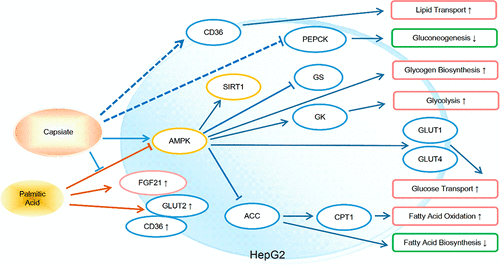当前位置:
X-MOL 学术
›
J. Agric. Food Chem.
›
论文详情
Our official English website, www.x-mol.net, welcomes your
feedback! (Note: you will need to create a separate account there.)
Improvement of Lipid and Glucose Metabolism by Capsiate in Palmitic Acid-Treated HepG2 Cells via Activation of the AMPK/SIRT1 Signaling Pathway
Journal of Agricultural and Food Chemistry ( IF 5.7 ) Pub Date : 2018-06-10 00:00:00 , DOI: 10.1021/acs.jafc.8b01831 Yufan Zang 1 , Li Fan 1 , Jihua Chen 1 , Ruixue Huang 2 , Hong Qin 1
Journal of Agricultural and Food Chemistry ( IF 5.7 ) Pub Date : 2018-06-10 00:00:00 , DOI: 10.1021/acs.jafc.8b01831 Yufan Zang 1 , Li Fan 1 , Jihua Chen 1 , Ruixue Huang 2 , Hong Qin 1
Affiliation

|
Capsiate, a nonpungent ingredient of CH-19 Sweet, exhibits anti-obesity effects on animals and humans. This study investigated the effects and molecular mechanism of capsiate on lipid and glucose metabolism in PA-treated HepG2 cells. Results showed that compared with the PA-alone group, 100 μM capsiate inhibited lipid accumulation, decreased TG (0.0562 ± 0.0142 vs 0.0381 ± 0.0055 mmol/g of protein; P = 0.024) and TC (0.1087 ± 0.0037 vs 0.0359 ± 0.0059 mmol/g of protein; P = 0.000) levels, and increased the HDL-C level (0.0189 ± 0.0067 vs 0.1050 ± 0.0106 mmol/g of protein; P = 0.000) and glycogen content (0.0065 ± 0.0007 vs 0.0146 ± 0.0008 mg/106 cells; P = 0.000) of PA-treated HepG2 cells; 100 μM capsiate also upregulated the level of CD36 (P = 0.000), phosphorylation of ACC (P = 0.034), and expression of CPT1 (P = 0.013) in PA-treated HepG2 cells, leading to an enhancement of lipid metabolism. Meanwhile, 100 μM capsiate upregulated the levels of GLUT1, GLUT4, GK, and phosphorylation of GS (P = 0.001, 0.029, 0.000, and 0.045, respectively) and downregulated the PEPCK level (P = 0.001) to improve glucose metabolism in PA-treated HepG2 cells. Furthermore, the levels of phosphorylation of AMPK and expression of SIRT1 in HepG2 cells were increased by a 100 μM capsiate treatment (P = 0.001 and 0.000, respectively), while the FGF21 level was decreased (P = 0.003). Most of these effects were reversed by pretreatment with compound C, a selective AMPK inhibitor. Thus, capsiate might improve lipid and glucose metabolism in HepG2 cells by activating the AMPK/SIRT1 signaling pathway.
中文翻译:

通过激活AMPK / SIRT1信号通路,在棕榈酸处理过的HepG2细胞中由衣壳酸改善脂类和葡萄糖的代谢。
辣椒素是CH-19 Sweet的一种非刺激性成分,对动物和人类具有抗肥胖作用。这项研究调查了衣壳酸对PA处理的HepG2细胞中脂质和葡萄糖代谢的影响及其分子机制。结果表明,与单独使用PA的组相比,100μM衣壳抑制了脂质的积累,降低了TG(0.0562±0.0142 vs 0.0381±0.0055 mmol / g蛋白质; P = 0.024)和TC(0.1087±0.0037 vs 0.0359±0.0059 mmol / g )克蛋白质; P = 0.000)水平,并增加了HDL-C含量(0.0189±0.0067对0.1050±0.0106 mmol / g蛋白质; P = 0.000)和糖原含量(0.0065±0.0007对0.0146±0.0008 mg / 10 6细胞; P= 0.000)的PA处理的HepG2细胞; 100μM衣壳酸还上调了PA处理的HepG2细胞中CD36的水平(P = 0.000),ACC的磷酸化(P = 0.034)和CPT1的表达(P = 0.013),从而导致脂质代谢增强。同时,100μM衣壳酸上调GLUT1,GLUT4,GK和GS的磷酸化水平(分别为P = 0.001、0.029、0.000和0.045),并下调PEPCK水平(P = 0.001)以改善PA-中的葡萄糖代谢治疗的HepG2细胞。此外,通过100μM的衣壳处理可以增加HepG2细胞中AMPK的磷酸化水平和SIRT1的表达(P分别为0.001和0.000),而FGF21含量却降低了(P = 0.003)。通过用选择性AMPK抑制剂化合物C预处理可以逆转大多数这些作用。因此,衣壳酸可能通过激活AMPK / SIRT1信号通路来改善HepG2细胞的脂质和葡萄糖代谢。
更新日期:2018-06-10
中文翻译:

通过激活AMPK / SIRT1信号通路,在棕榈酸处理过的HepG2细胞中由衣壳酸改善脂类和葡萄糖的代谢。
辣椒素是CH-19 Sweet的一种非刺激性成分,对动物和人类具有抗肥胖作用。这项研究调查了衣壳酸对PA处理的HepG2细胞中脂质和葡萄糖代谢的影响及其分子机制。结果表明,与单独使用PA的组相比,100μM衣壳抑制了脂质的积累,降低了TG(0.0562±0.0142 vs 0.0381±0.0055 mmol / g蛋白质; P = 0.024)和TC(0.1087±0.0037 vs 0.0359±0.0059 mmol / g )克蛋白质; P = 0.000)水平,并增加了HDL-C含量(0.0189±0.0067对0.1050±0.0106 mmol / g蛋白质; P = 0.000)和糖原含量(0.0065±0.0007对0.0146±0.0008 mg / 10 6细胞; P= 0.000)的PA处理的HepG2细胞; 100μM衣壳酸还上调了PA处理的HepG2细胞中CD36的水平(P = 0.000),ACC的磷酸化(P = 0.034)和CPT1的表达(P = 0.013),从而导致脂质代谢增强。同时,100μM衣壳酸上调GLUT1,GLUT4,GK和GS的磷酸化水平(分别为P = 0.001、0.029、0.000和0.045),并下调PEPCK水平(P = 0.001)以改善PA-中的葡萄糖代谢治疗的HepG2细胞。此外,通过100μM的衣壳处理可以增加HepG2细胞中AMPK的磷酸化水平和SIRT1的表达(P分别为0.001和0.000),而FGF21含量却降低了(P = 0.003)。通过用选择性AMPK抑制剂化合物C预处理可以逆转大多数这些作用。因此,衣壳酸可能通过激活AMPK / SIRT1信号通路来改善HepG2细胞的脂质和葡萄糖代谢。





















































 京公网安备 11010802027423号
京公网安备 11010802027423号